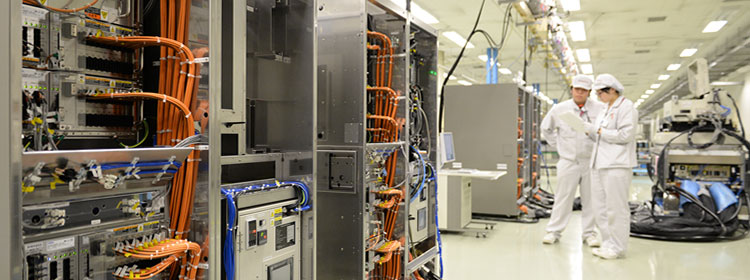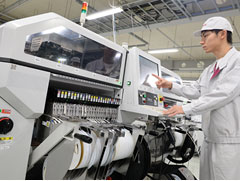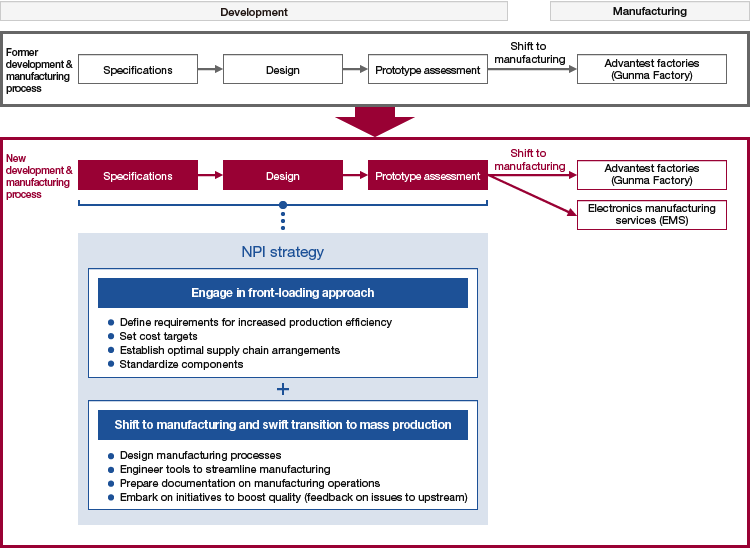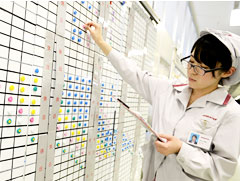 網站內容顯示
網站內容顯示




We are leveraging economies of scale emerging from our integration of the former Verigy Ltd. to achieve an even greater industry presence.
Advantest is forging a new approach to production that draws on the combined advantages of in-house manufacturing and EMS production, thus venturing beyond differences in production engineering philosophies and manufacturing approaches.

In recent years the semiconductor industry has been undergoing a transformation that involves increasingly globalized divisions of labor across national boundaries, accompanied by a rapid shift of semiconductor production to Taiwan, Korea, China and other Asian countries. Such changes compel a flexible approach, as the need to prevail amid fierce competition makes it crucial that companies create operating structures comprising optimally-located production facilities capable of swiftly delivering superior products in line with market demands.
Consequently, Advantest has been pursuing numerous strategies toward creating an optimal production framework along these lines on a global scale, capable of flexibly developing and supplying products geared toward customer needs. Toward that end, we have been fully leveraging economies of scale brought about through our integration of Verigy's operations, while combining production at our own factories with capacity from electronics manufacturing services (EMS).
We are also placing particular emphasis on our new product introduction (NPI) initiatives which are designed to enable low-cost mass production at optimally-located factory sites. Such initiatives entail cutting production costs by enlisting teams of specialist employees from fields such as design, production technology, procurement and quality assurance in the initial phases of new product development, who then carefully select components and draft exacting production plans that ensure streamlined operations, while also ensuring that costs are kept well under control. Before introducing our NPI program, our production divisions in Japan, for instance, which were then mainly engaged in manufacturing at our own factories, would for the most part try to cut costs by giving careful consideration to assembly and wiring techniques and manufacturing processes, while using components selected in the design phase. Now, through NPI initiatives we strive to gain a greater competitive edge through cost cutting initiatives geared toward processes more in the upstream realm. The NPI scheme was fully adopted with the launch of the first new product development project after the Verigy integration, through which Advantest Japan has been working with overseas divisions handling the project in pursuing sweeping innovation within operations from product development all the way to mass production processes.
NPI initiatives


We have also been working to make the most of economies of scale emerging from the Verigy integration by taking steps to fuse the respective organizational entities while melding differing approaches to work.
In the procurement realm, for instance, we are giving shape to a purchasing framework that enables us to source quality parts worldwide on favorable terms. This has entailed setting up individual purchasing teams on the basis of component categories, with such teams having been launched for procurement of commodity components, application-specific integrated circuits (ASICs), power supply-related parts and other such components. Through that initiative, our procurement workforce has been sharing intelligence within each of the purchasing teams, and also across the company's entire procurement structure throughout Japan and elsewhere in the world.
Meanwhile, we have also been working to streamline operations in the production management realm by integrating production planning across the entire Advantest Group, while also ensuring leaner meetings overall. Toward that end, we have been taking steps to merge meetings covering long-term demand forecasts and production planning thus far held on separate occasions by production divisions in Japan and those overseas.
We are well aware that the task of flexibly addressing challenges emerging amid a changing world and evolving markets in order to prevail while facing stark competition requires that we take on new ideas and perspectives on the road ahead, while persistently seeking out better approaches to business, rather than holding to those of the past. With Advantest now embarking on efforts to forge an optimal production framework on a global scale, we set our sights on pursuing all-out manufacturing innovation from this point forward.
Staff Voices
-
 Production Group Kenichi Hirose
Production Group Kenichi Hirose-
Reaping the advantages of globally-optimized production through an efficient transfer of manufacturing capacity
My first product development task after our integration of the former Verigy Ltd. entailed acting as a member of the NPI Team on the Japan side. I travelled to the U.S. on several occasions six months or so before the release of the new product, starting from the initial prototype creation and assessment stage. After that, I spent over four months there involved in undertakings such as working out schedules with development operations in the U.S. and production units in Japan, and gathering and relaying information to facilitate materials procurement. These efforts helped ensure that the product was shipped on time. Going forward, I intend to stand behind the company's efforts to make the most of its globally-optimized production structure by helping to establish a consistent structure throughout the world for enabling more efficient transfer of production capacity, whether involving our own plants or outsourcing to electronics manufacturing services.
-
 Advantest (Singapore) Pte.Ltd. Catherine Chang
Advantest (Singapore) Pte.Ltd. Catherine Chang-
Forging win-win relationships with our suppliers
I work as a procurement manager responsible for sourcing FPGAs, standard semiconductors and memory modules used in V93000 series testers. Since our integration with the former Verigy Ltd. in April 2012, those of us involved in procurement for Advantest have been setting up optimal procurement schemes and policies designed to better streamline operations, while also pursuing economies of scale by making purchases in bulk on a Group-wide scale. Among our efforts to make this strategy work, we have been negotiating prices on the basis of Group-wide purchase volumes, coming together to form strategic supplier assessments, and further performing investigations regarding conflict minerals relevant to our supply chain, while at the same time we have been working to build win-win relationships with our suppliers.
 |  |  |  |


